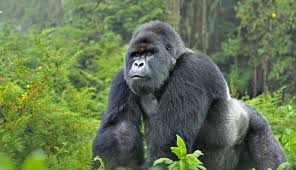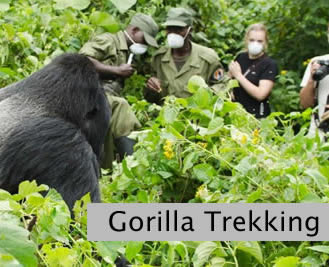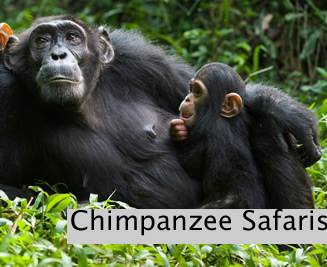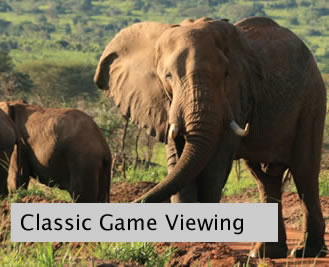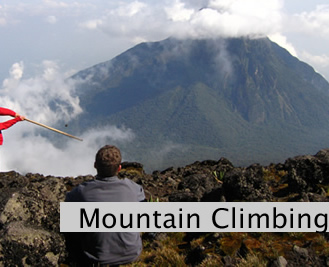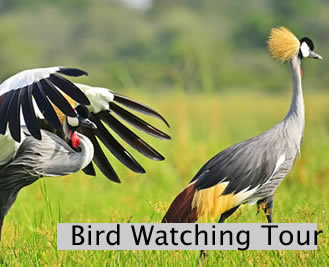The cost of a gorilla safari in Uganda can vary depending on several factors such as the tour operator, the number of days, the level of accommodation, and whether it’s a group or private tour. However, as of today, the typical cost for a gorilla trekking permit in Uganda is $800 USD per person. This permit allows you to track gorillas in Bwindi Impenetrable National Park or Mgahinga Gorilla National Park.
In addition to the permit cost, you would need to consider the cost of accommodation, transportation, and possibly other tour activities included in the package. Generally, a full 1 or 2 days’ gorilla safari package including permits, accommodation, meals, and transportation can range from $1,700 to $2,500 USD or more per person, depending on the level of luxury and services provided. Our team is always available online to guide you on anything to do with Safaris in Uganda and Rwanda. You can either send an email or send a WhatsApp message on our contacts.
How Difficult is Gorilla Trekking in Uganda
Gorilla tracking in Uganda can vary in difficulty depending on several factors such as the location of the gorilla group you are tracking, weather conditions, and your own physical fitness level. Here are some of the things to bear in mind as you plan to go for Gorilla trekking in the mountains:
- Terrain: The terrain in the gorilla habitats can be quite challenging. You may encounter steep slopes, dense vegetation, and uneven ground. In some cases, you may need to hike for several hours through dense forest to reach the gorilla group.
- Altitude: Gorilla tracking often takes place at higher altitudes, which can make the trek more physically demanding, especially if you are not acclimatized to the altitude.
- Weather: Weather conditions can also affect the difficulty of gorilla tracking. Rain can make trails muddy and slippery, adding to the challenge of navigating through the forest.
- Duration: The duration of the trek can vary from a few hours to a full day, depending on where the gorillas are located at the time of your visit. Some groups may be closer to the starting point while others may require longer hikes.
- Porters and Guides: To help mitigate some of the physical demands, porters are often available to carry equipment and assist you during the trek. Experienced guides also accompany groups to ensure safety and provide information about the gorillas and their habitat.
Overall, while gorilla tracking in Uganda can be physically demanding, it is a highly rewarding experience for those interested in wildlife and conservation. It’s recommended to be in reasonably good physical condition and to follow the advice of your guides to ensure a safe and enjoyable trekking experience.
People also ask
How Safe is Gorilla Trekking?
Gorilla trekking is generally considered safe when conducted under the supervision of experienced guides and following established guidelines. The gorillas have been habituated and are now used to the presence of humans. The conservation procedures have been put in place to avoid any interference with trekking process. The gorillas are visited once each day for one hour to avoid stressing them. This ensures safety of the guests since the Gorillas are not threatened and stressed with the presence of humans. Some of the guidelines put in place to ease Gorilla trekking and ensure safety of the visitors include the following:
- Guided Tours: Gorilla trekking is typically organized through guided tours provided by licensed and trained guides. These guides are knowledgeable about the behavior of gorillas and the terrain, which enhances safety.
- Group Size: Tour groups are usually small, which allows for personalized attention and minimizes impact on the gorillas and their habitat.
- Health Precautions: Before trekking, visitors are required to undergo a health check to ensure they are not carrying any contagious diseases that could be passed to gorillas. This protects both the gorillas and humans.
- Physical Demands: Gorilla trekking can involve hiking in sometimes challenging terrain, including steep slopes and dense vegetation. It’s important to be reasonably fit and prepared for these physical demands.
- Respect for Gorillas: Rules and guidelines are in place to protect the gorillas and ensure minimal disturbance to their natural behavior. Visitors are instructed to maintain a safe distance (typically 7 meters or more) and avoid direct eye contact with the gorillas.
- Security: In areas where gorilla trekking occurs, security measures are generally in place to ensure the safety of visitors. This includes protection from wildlife and potential hazards in the environment.
- Local Conditions: It’s essential to stay informed about local conditions and follow the advice of guides and authorities, especially in regions where there may be political instability or other risks.
Generally, while gorilla trekking involves some inherent risks associated with wildlife and outdoor activities, adherence to guidelines and the expertise of guides significantly mitigate these risks.
Which Country is Best For Gorilla Trekking?
The two primary countries renowned for gorilla trekking are Rwanda and Uganda, both offering unique experiences and considerations:
Rwanda:
- Accessibility: Rwanda’s Volcanoes National Park is close to the capital city, Kigali, making it convenient for travelers with limited time.
- Gorilla Habituation Experience: Rwanda offers a unique gorilla habituation experience, allowing longer and more immersive encounters with gorilla families, though it can be more expensive.
- Mountain Gorilla Population: Rwanda is home to a significant portion of the mountain gorilla population, particularly in Volcanoes National Park.
Uganda:
- Biodiversity: Uganda offers a more diverse safari experience beyond gorilla trekking, including savannah wildlife like lions and elephants in addition to the gorillas.
- Gorilla permit Cost: Gorilla trekking in Uganda is cheaper than Rwanda, making it a more budget-friendly preference for most tourists.
- Multiple Habitats: Bwindi Impenetrable National Park and Mgahinga Gorilla National Park in Uganda provide diverse habitats for gorillas, offering different trekking experiences.
Choosing Between Rwanda and Uganda:
- Time and Budget: If you have limited time and can afford higher permit costs, Rwanda might be preferable due to its proximity to the capital Kigali and the shorter travel distances involved.
- Safari Interests: If you are interested in combining gorilla trekking with a broader safari experience that includes savannah wildlife, Uganda offers a more diverse range of activities.
- Gorilla Habituation: If you are particularly interested in spending extended time with gorillas during the habituation process, Rwanda’s gorilla habituation experience may be more appealing.
Both countries are committed to conservation efforts, ensuring sustainable tourism practices and providing memorable experiences while protecting these critically endangered animals. The choice between Rwanda and Uganda may depend on your specific interests, budget, and travel preferences.
What is the most Economical Approach to See Gorillas in Uganda?
The cheapest way to see gorillas in Uganda involves several considerations to minimize costs while still ensuring a safe and rewarding experience:
- Choose Bwindi Impenetrable National Park: Bwindi is home to several gorilla families and generally offers more affordable gorilla permits compared to Mgahinga Gorilla National Park. The southern sector of Bwindi (Rushaga and Nkuringo regions) tends to have a slightly higher number permits available compared to the northern sectors.
- Book Directly with Uganda Wildlife Authority (UWA): Gorilla permits are sold by the Uganda Wildlife Authority. Booking directly through their website or office in Kampala and let the tour operator do other things for you.
- Choose Budget Accommodation: Bwindi has a range of accommodation options, including budget lodges and guesthouses. Staying at these more affordable places can significantly reduce your overall expenses.
- Consider Off-peak Season: Gorilla permits may be slightly cheaper during the low season (April, May, November), although weather conditions can be less predictable during these months.
- Group Size: Gorilla trekking permits are issued for specific groups, and joining a larger group can sometimes be cheaper than arranging a private trek. However, this may limit your ability to control the pace and experience of the trek.
- Prepare for Additional Costs: While cutting costs is important, ensure you have adequate funds for necessary expenses such as transportation, accommodation, meals, and tips for guides and porters.
Plan carefully and choose the right options for your budget, you can have a memorable gorilla trekking experience in Uganda without breaking the bank.
Is Gorilla Trekking Cheaper in Uganda then Rwanda?
Yes, gorilla trekking is generally cheaper in Uganda compared to Rwanda. Some of the key facts to think over on include:
- Gorilla Permit Costs: As of recent information, gorilla trekking permits in Uganda cost $800 per person for foreign non-residents, while in Rwanda, they cost $1,500 per person for all visitors (as of April 31st 2024). This price difference makes Uganda a more affordable option for gorilla trekking.
- Accommodation: Accommodation options in Uganda can vary widely in price, but generally, there are more budget-friendly options available compared to Rwanda, where accommodations tend to be more expensive.
- Travel Costs: Transportation costs can also influence overall expenses. Uganda’s Bwindi Impenetrable National Park and Mgahinga Gorilla National Park are located at varying distances from major cities like Kampala or Entebbe, but travel within Uganda is generally less expensive compared to Rwanda.
Uganda largely offers a more budget-friendly option for gorilla trekking compared to Rwanda, making it a popular choice for travelers looking to experience mountain gorillas in their natural habitat at a lower cost.
Which Month is Best For Gorilla Trekking?
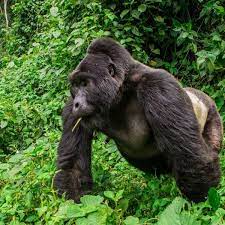 The best months for gorilla trekking typically coincide with the dry seasons in Rwanda and Uganda. The dry seasons are generally considered the optimal times to visit due to better trekking conditions and clearer views. Here are the recommended months:
The best months for gorilla trekking typically coincide with the dry seasons in Rwanda and Uganda. The dry seasons are generally considered the optimal times to visit due to better trekking conditions and clearer views. Here are the recommended months:
- June to September: This period corresponds to the mid-year dry season in both Rwanda and Uganda. Weather is generally cooler, and there is less rainfall, making trekking conditions more comfortable and trails less muddy.
- December to February: This period is also a dry season in Rwanda and Uganda, making it another good time for gorilla trekking. Days are often sunny with pleasant temperatures, and wildlife viewing is generally good.
Choosing a specific month within these periods can depend on personal preferences such as weather conditions and travel schedules. It’s important to note that gorilla trekking is possible year-round, but the dry seasons typically offer the most comfortable and reliable conditions for trekking and wildlife viewing.
How is a permit to see gorillas in Uganda?
As of the latest information, the cost of a gorilla trekking permit in Uganda is $700 per person for foreign non-residents. This fee is set by the Uganda Wildlife Authority (UWA), which manages the national parks where gorilla trekking activities take place, primarily in Bwindi Impenetrable National Park and Mgahinga Gorilla National Park.
It’s important to note that gorilla trekking permits in Uganda are subject to availability and should be booked well in advance, especially during the peak tourist seasons. The permit cost contributes to conservation efforts aimed at protecting mountain gorillas and their habitats, ensuring sustainable tourism practices.
For residents of East African Community (EAC) countries, the permit cost is lower, set at approximately 250,000 UGX per person. Prices may change over time, so it’s advisable to check with the Uganda Wildlife Authority or authorized tour operators for the most up-to-date information and availability.

